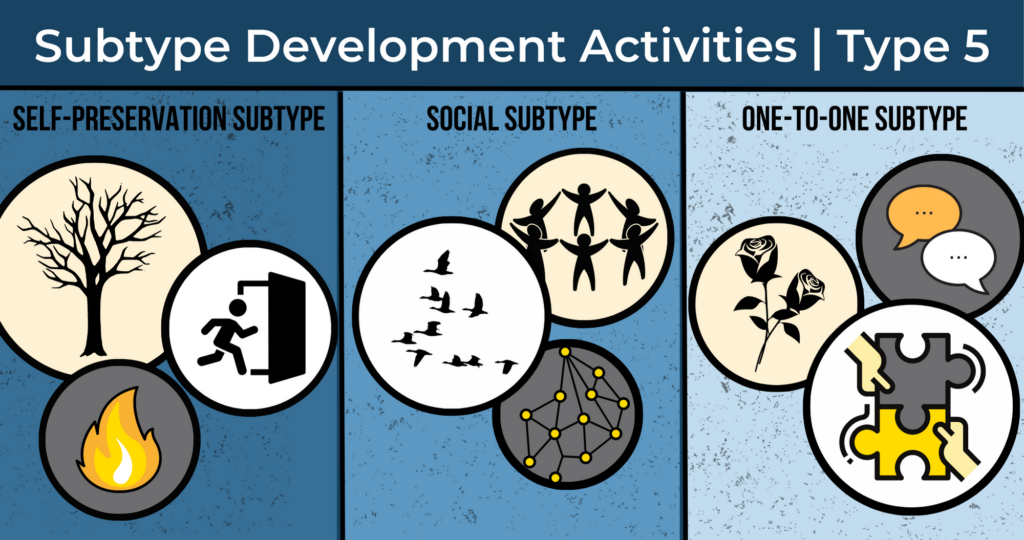There are three versions of each Enneagram type called subtypes: self-preserving subtype, social subtype and one-to-one subtype. Subtypes are formed when the emotional patterns or habits of our type, also called the type’s passion or vice, intersect and combine with one of the three basic human instincts, the instinct that is most activated within us: self-preservation instinct, social instinct or one-to-one instinct. We may have more than one activated instinct, so we could relate to two or even all three subtypes for our type.
Each instinct has specific focal areas. Individuals with that activated instinct, once it combines with the emotional pattern of our type, may move toward that instinctual area, away from that arena, or have ambivalence about that area. A way of understanding this is that the instincts by themselves are simply human and natural. However, when the activated instinct(s) combines with our type-based emotional pattern, the instinct then becomes distorted and, thus, less able to satisfy our natural needs in that instinctual area.
Here you can read about the passion or emotional habit of the type, a name for and a description of that subtype as it combines the emotional habit with that instinct, followed by one specific development idea that is particularly useful to people of that subtype. Please remember that we may have more than one active subtype, so the development activities for the additional subtype are also good for your development.
FIVES
Emotional pattern of Avarice
The intense drive to acquire information, knowledge and wisdom and to avoid intrusion and loss of energy, but also to guard and preserve the resources they think they might need
Self-preservation Five subtypes
Self-Preservation Five subtypes (“castle”) are highly concerned with being intruded upon and being overextended physically and energetically and for this reason, minimize their direct involvement with others at the same time as they hoard their scarce resources.
Self-preservation Five subtype development
Notice how you retract, hide and create strong and non-penetrable boundaries, thus limiting your contact with others; engage more in the outside world.
One way to engage more in the outside world:
When you go to a meeting or even a social event, instead of arriving just on time, go 5-10 minutes early and engage with others in a less structured way. Experience what happens.
Social Five subtypes
Social Five subtypes (“totem” ) find, develop and guard or hoard their strong connections with people and groups who share their super-ideals and values, but become disengaged from these groups if they discover they are not fully aligned with these higher-order beliefs.
Social Five subtype development
Notice how your quest for connection through knowledge and ideas allows you to connect with some people, particularly in groups, but also limits your contact with many others; engage more with people in a variety of ways.
One way to engage more with people in a variety of ways:
Are there people you meet who aren’t connected to groups that share your higher-order values, even if these individuals share values in common with you? Identify these people and initiate a gentle suggestion to spend more time together for tea, coffee, a walk or a run. This can help you expand the people with whom you engage and go beyond the pattern of finding your connection in others primarily through groups.
One-to-One Five subtypes
One-to-One Five subtypes (“confidence”) search for a strong, deep connection with one other person whom they trust and can share confidences or private information with, then guard for themselves the other person and this special relationship.
One-to-One Five subtype development
Notice how your high expectations and testing of others limit your relationships; take the risk of sharing your real feelings with more people.
One way to take the risk of sharing your real feelings with more people:
Make a list of your requirements for those with whom you are interested in and willing to have a special relationship – in other words, those with whom you have enough confidence in and are thus willing to share your private or confidential thoughts and feelings. Ask yourself this: Why do I have such a list; What is its purpose? What do I gain from having this list and how does adhering to it limit me and the possible relationships I could have?
These activities are excerpts from the new additions to the soon-available 3rd edition of The Enneagram Development Guide, with over 60 development activities for each Enneagram type.
Ginger Lapid-Bogda PhD, author of nine Enneagram books, is a speaker, consultant, trainer, and coach. She provides certification programs and training tools for business professionals around the world who want to bring the Enneagram into organizations with high-impact business applications. TheEnneagramInBusiness.com | ginger@theenneagraminbusiness.com


Comments are closed.